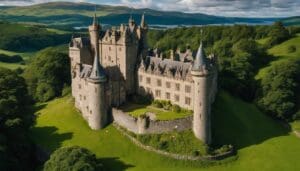Best Things To Do In Beautiful Murcia!
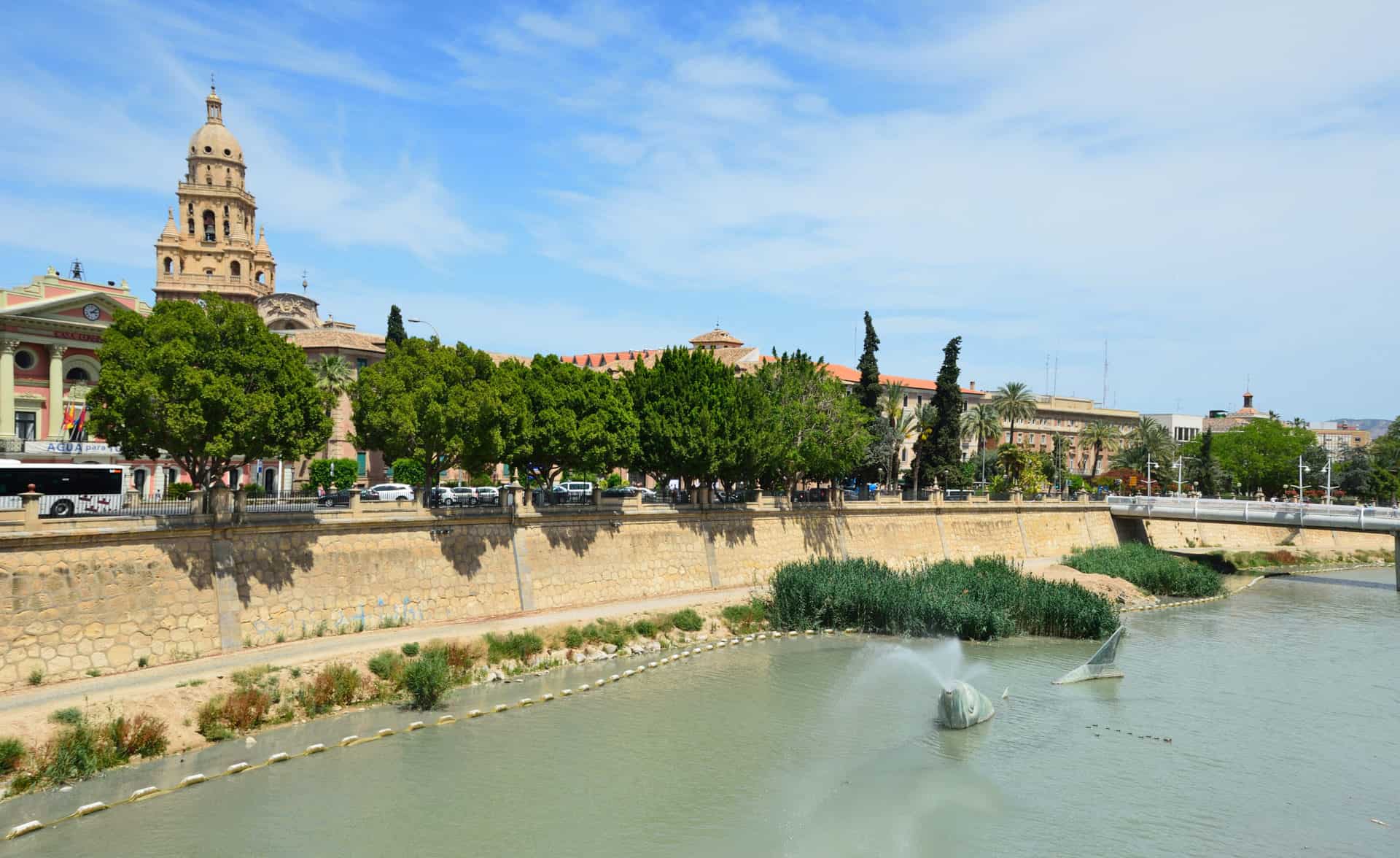
Updated On: November 08, 2023 by Esraa Mahmoud
If you hear the word Spain, you probably think of Madrid, Barcelona, Seville, or Valencia. But there is a hidden gem in the southeast of the country of Cervantes, bulls, and flamenco that you should know of: the region of Murcia, which offers you beaches, great wines, culture, and authenticity.
Nestling 40 km from the Mediterranean Sea, Murcia is a sun-drenched region in eastern Spain. Here, you can enjoy delicious food, learn about the rich history of the region and admire the majestic Baroque architecture. No one seems to be in a hurry to get anywhere in this city – even the Cathedral was built here for 300 years.
Murcia has something for every taste; water sports enthusiasts can enjoy all disciplines. History buffs will not know where to turn, stunned by the vestiges of all religions and eras. Aficionados of Hispanic culture, on the other hand, will be totally in the right place. Plus, if you’re looking for warmth, we promise you’ll get your vitamin D up for sure here!
The capital of this region is also named Murcia! As confidential as it is rich, it is a city full of charm and curiosities. Enclosed in the neighboring region of Andalusia and the Community of Valencia, erected in 821, it is also located in the center of the valley of the River Segura. The city has preserved the legacy of its glory days, as evidenced by the remains of the great wall surrounding it and, once, fiercely protecting it.
Bringing you the best of what the region has to offer, here are the best things to do in Murcia and the best places to visit.
Murcia Cathedral
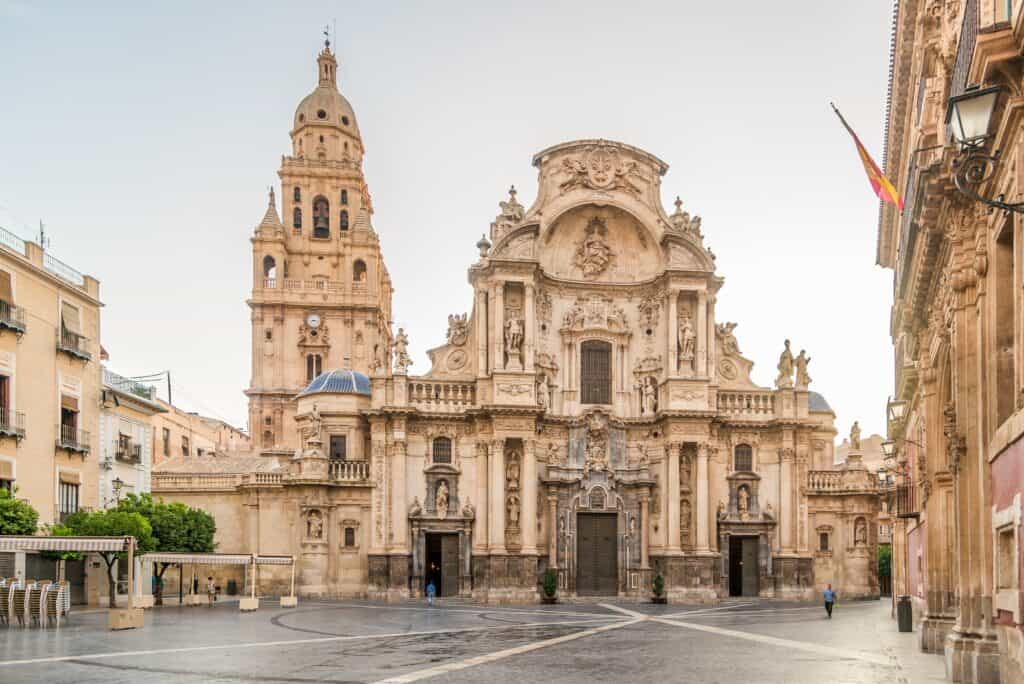
The city’s cathedral has a great mix of architectural styles, but it’s the 17th and 18th-century Baroque additions that really stand out. The main Baroque-style facade in Plaza del Cardenal Belluga is breathtakingly grand, with its bold columns and beautiful sculpture of the Virgin Mary with the Archangel above the main portal. Inside, you’ll pass numerous lavish chapels but make sure to look for the tomb of King Alfonso X of Castile.
Also, don’t forget the bell tower; at 93 meters, it’s the second tallest in Spain (behind Seville’s Giralda). It took more than 250 years for the tower to be completed. When it was completed in 1793, it fused Renaissance, Baroque, Rococo, and Neoclassical styles. In the 1700s and 1800s, this city in eastern Spain experienced an economic boom that endowed it with some magnificent pieces of Baroque art and architecture.
Monuments like the cathedral and Francisco Salzillo’s sculptures have to be your first port of call to see the best of Murcia’s culture.
Salzillo Museum
Museo Salzillo is the most popular of all Murcia museums, dedicated to the work of the famous sculptor and Murcia native Francisco Salzillo. In this museum, you’ll see many of the stunning pieces he designed for Semana Santa and learn more about the Baroque movement in Murcia at a time when the city was expanding and becoming wealthy from the silk trade.
The sculpture here reflects that sense of confidence with opulent, gilded Passion scenes full of drama commissioned by Christian brotherhoods and churches. Also, check out Salzillo’s stunning nativity scene with a large number of miniature figures.
Real Casino de Murcia
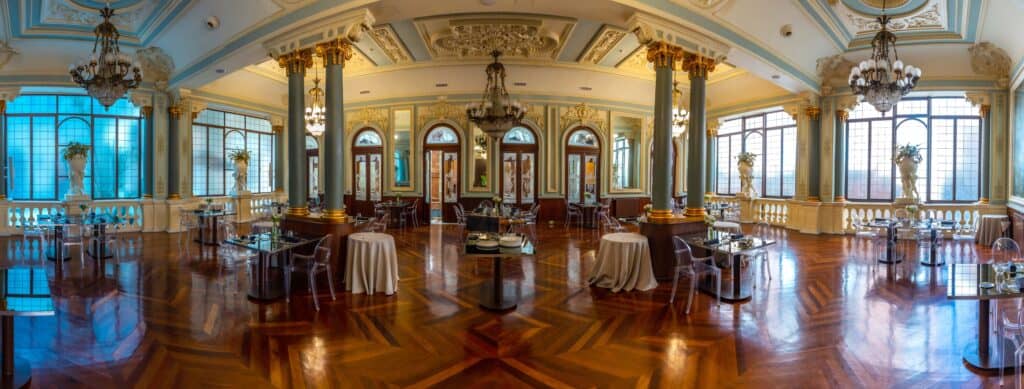
Another landmark with a very eclectic design is the Gentleman’s Club. The construction of the club began in the mid-19th century but was not completed for another 60 years. This is still a private club, but you can book a tour, and you won’t regret it. The exterior is grand enough, but the interiors are wonderfully classy.
The billiards room, for example, has Moorish inclinations with a geometric coffered ceiling, as does the courtyard with a two-story gallery modeled after the grand palaces of Andalusia. The ballroom has an opulent rococo design and a ceiling fresco depicting Murcia’s most famous cultural figures, such as Francisco Salzillo. The Real Casino is for sure one of the most beautiful places to visit in Murcia.
Plaza de las Flores
The Plaza de las Flores is located a short distance west of the cathedral, and it is probably the most beautiful square in the city. The square got its name from the florists who still do business here today.
The surrounding townhouses date from the late 19th and early 20th centuries, like the Edificio de Tejidos Abad, a beautiful Art Nouveau building with white square window bays. While there, make sure to stop by one of the cafés and read the paper in the morning, or head to one of the bars for a beer and tapa in the evening.
Plaza Cardenal Belluga
In Plaza del Cardenal Belluga you can see some of the best monuments of Murcia. From this square, you can see the beautiful facade of the Cathedral as well as the City Hall of Murcia, a neoclassical structure built in the middle of the 19th century.
In 1998, a modern building was added to the town hall, designed by Rafael Moneo, which contrasts markedly with the surrounding lush architecture. Here on the square is the Bishop’s Palace, an eighteenth-century Rococo building. The building complements the Baroque additions of the Cathedral.
Museum of the Monastery of Santa Clara la Real
This historic convent is still located in the middle of the city on Gran Via Alfonso X el Sabio. When you visit, you can only see about a quarter of the complex, but that’s more than enough to show you what a fascinating and beautiful place this is.
It was built in the 13th century over the former Moorish Alcazar (fortified palace) of Murcia. So there are many decorative Arabic elements such as horseshoe arches incorporated into the design of the monastery and displayed in the museum, where expertly crafted wood and plaster decorations are on display. The museum is one of the best places to visit in Murcia.
Episcopal Palace
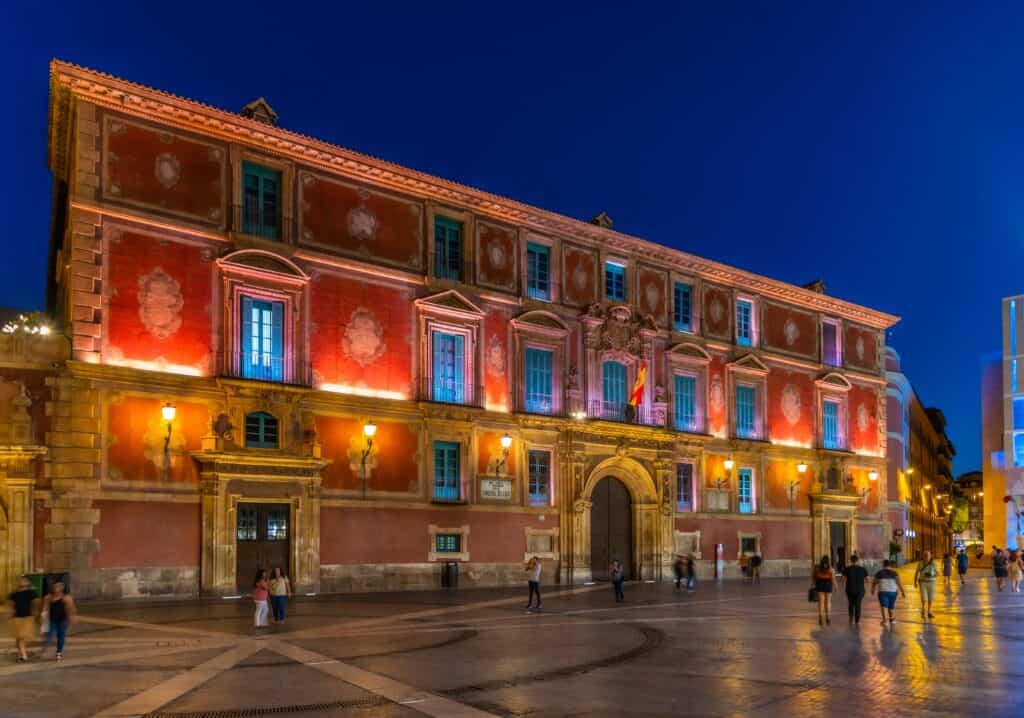
Palacio Episcopal next to the Cathedral, is one of the most striking sights in the center of Murcia. Here, you can admire the palace’s opulent facade, wander around the courtyard, and consider the grand staircase. One of the doors leads to the Baroque chapel, where you can see the wafers blessed during mass. The palace is one of a kind, and it is not to be missed.
Floridablanca Garden
In Murcia, summer can get vicious. So, when it gets really hot, you can take the Puente Viejo to the other side of the Segura River and seek refuge in this little oasis, AKA Jardín Floridablanca, or Floridablanca Garden. It is the oldest public park in the city and was opened in the mid-19th century. Before that, this was a rural promenade on the right bank of the river.
Murcia grew soon after and the city decided to build this park with flower beds, refined paths, and arbors so that people could escape the sun. It was one of the first projects of this kind in Spain. The largest trees here are old ficuses with supporting roots that take over everything around them.
Jardín Floridablanca is a small but very picturesque urban garden. Here you can see several luxurious banyan trees with long and thick aerial roots, as well as numerous cypresses, palm trees, violet trees, and lush rose bushes. There are benches in the shade of the trees where you can rest and admire the beauty of the surroundings.
Monteagudo Castle
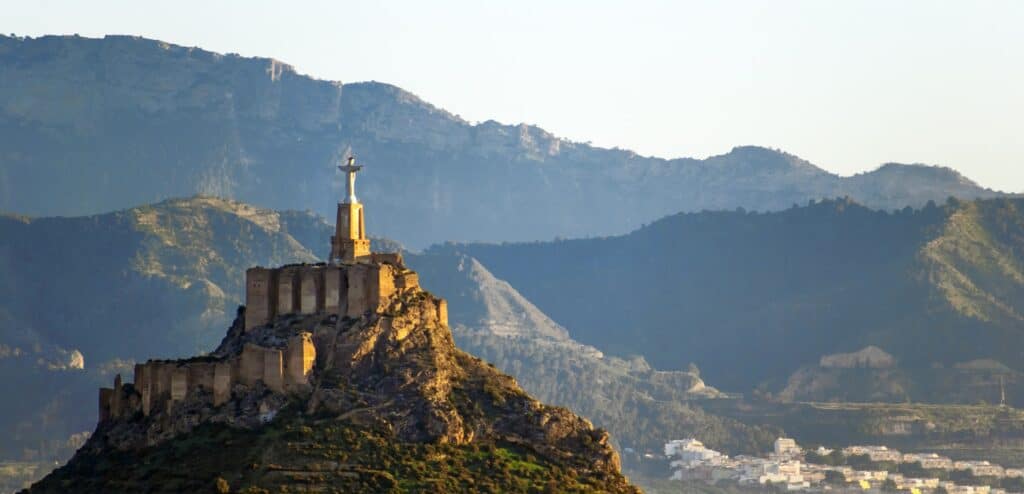
Outside the northeastern suburbs rises a rocky limestone mountain 149 meters high. What you’re about to see is a large statue of Christ on the castle wall. It dates from the 20th century and was erected in the 1950s after an earlier statue from the 1920s was destroyed in the Civil War.
The castle was a strategic defense for the Moorish taifa of Murcia for around 250 years. The granaries here were designed so that the castle could withstand long sieges. After the defeat of the Moors, the Castilian king Alfonso X used the castle as a Murcian residence.
Archaeological Museum of Murcia
Not many tourists make it here, but this museum will delight all history buffs. That’s because there are more than 2,000 archaeological sites throughout the Murcia region. Besides the Roman and Moorish heritage, the best discoveries are from the Bronze and Iron Ages of the Iberian culture.
These people were influenced by trade with the Phoenicians and Etruscans, as you will see from the bold designs on pottery from this period. The León de Coy is a wonderful, almost abstract lion sculpture found in a necropolis from the 4th century BC.
Almudí Palace
This magnificent building was completed in 1629 and stood on the site of a burned predecessor. It is another manifestation of the wealth that flooded into the local economy during this period, thanks to the silk industry.
Before entering, look at the large relief of the Habsburg coat of arms, flanked by two smaller emblems for the city of Murcia. Inside is a beautiful Tuscan-style hall with rows of columns supporting wide arches. This elegant space is used for temporary art exhibitions.
Terra Natura Murcia
This zoo has several branches throughout Spain and has been highly praised for its humane approach. At Terra Natura, there are no cramped pens or bars. Instead, they try to create enclosures that are as close to the animal’s natural habitat as possible. To that end, they have planted 500 trees and shrubs throughout the park.
As for the zoo’s inhabitants, there are more than 300 animals from 50 species here. Among them are endangered animals such as the European lynx, the brown bear, and the Iberian wolf, which only exist in small numbers in the wild. Other exotic animals include hippos, lions, giraffes, white rhinos, and an assortment of birds and reptiles.
Semana Santa and Bando de la Huerta
The Easter season offers you the ultimate crash course in Murcian culture. First, there are the world-famous marches of the Christian brotherhoods with sculptures designed by Salzillo. This event has gained international tourist interest in Spain.
Just a few days after this celebration comes the fun and levity of Bando de la Huerta, Murcia’s one-day spring festival. The whole town turns out and most are dressed in Murcian costumes. In the main parade, horses, donkeys, ox carts, and the giants and cabezudos (large papier-mâché figures) leave the Don Juan Manuel neighborhood and make their way through downtown. There are also rolling snack stands handing out free sandwiches and Murcian blood sausage.
Torre de la Horadada
The Mediterranean Sea is only 50 kilometers away, so you can relax on a beach within an hour of leaving Murcia. If you take the RM-1 directly east of the city, you’ll reach the quiet beach communities on the southern end of the Costa Blanca.
One of the best beaches there is the Torre de la Horadada, which has two Blue Flag sandy beaches with tempting chiringuitos (beach bars) where you’ll get hungry for sea air. Also, the Mar Menor inland lagoon a few kilometers south is one of Spain’s greatest water sports destinations. It is worth mentioning that the mud in Las Charcas on the north coast is said to have medicinal properties.
Carrascoy and El Valle Regional Park
If Murcians want fresh air and scenery, they don’t have to go far. As a large natural park is located just six kilometers from the southern outskirts of the city. One of the easiest excursions is to the Santuario de la Fuensanta, on a hill at the foot of the mountains with an “Instagrammable” city panorama.
You’ll recognize it by its two whitewashed Baroque towers. Behind them is a mountainous landscape, and the park’s paths are lined with wild herbs like thyme and rosemary and wind through forests of Aleppo pines and Kermes oaks.
Science and Water Museum
The Museo de la Ciencia y del Agua is a city museum located on the banks of the river. Visiting the museum is one of the best things to do in Murcia with children – they will love the interactive exhibits where you can press buttons and turn knobs. There are also aquariums and a small planetarium in the museum.
The Verónicas Market
Mercado de Verónicas is the central market of Murcia, a few steps away from the Almudi Palace. To enjoy the authentic taste of Spanish products, make sure to buy those labeled Denominación de Origen. The Murcia countryside is home to paprika, one of the main ingredients in many Spanish dishes, and the local cheese is made from goat’s milk. Many types of Spanish fruits and vegetables are also grown in the Murcia region, so you can be sure that you are buying really fresh farm products from one of the 116 market stalls.






